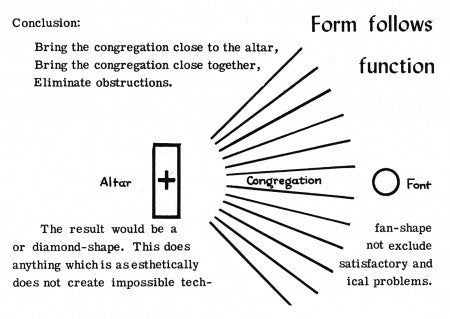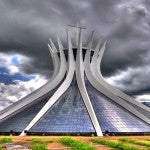Since the neoclassical era, church architecture hasn’t changed much., even when the world went through the romantic and realist periods. Then, the Industrial Revolution brought forth a lot of changes. Societies began to focus on technology and more efficient ways to do things.
Architects wanted a more modern twist to structures. Put to mind was a combination of technology with designs based on function. It was there that Modern architecture was born.
Modern architecture thrived during the 20th century. This was when technology became the central focus of everything. Functionality was a priority foremost.
Below are the characteristics of the Modern architectural movement.
Function-Inspired
 An outline of a church's form and function. Image source: Institute for Sacred Architecture
An outline of a church's form and function. Image source: Institute for Sacred Architecture
The idea that “form follows function” thrived as a principle that a building should stand based on its purpose.
General aspects of Modernist structures followed a purpose. Renowned architect Louis Sullivan relied on the environment whenever he designed a building. Examples of such buildings are the Auditorium Building in Chicago and the Wainwright Building in Missouri.
Simplicity and Minimalism
 A minimalist church concept in France. Image source: Trendhunter
A minimalist church concept in France. Image source: Trendhunter
Ornaments and adornments were often shunned in Modern architecture, as they were not treated as relevant to the structure’s function. Buildings were to be simpler and cleaner.
Transparency
 The interior of a Modernist church. Image source: Flickr
The interior of a Modernist church. Image source: Flickr
The insides of buildings would often be visible from the outside. Gone were interiors hidden behind thick solid walls. Trusses and support beams could be seen by many.
Outdoor Connection
 A Modern churchyard. Image source: Catholic Answers Forum
A Modern churchyard. Image source: Catholic Answers Forum
Modern architecture places emphasis on being one with nature. As significant as the lot area is, so is its composition. Landscaping became commonplace. By that, architects developed outdoor spaces and natural lighting illuminated the interiors.
Examples of Modern Architecture
Chapel Notre Dame de Haut, France (1954)
 Image source: Bluffton.edu
Image source: Bluffton.edu
Cathedral of Brasilia, Brazil (1970)
 Image source: Human and Natural
Image source: Human and Natural
Parish Church of Santa Monica, Spain (2006)
 Image source: Contemporist
Image source: Contemporist
Sunset Chapel, Mexico (2011)
 Image source: Arch Daily
Image source: Arch Daily
Throughout the 20th century, Modern architecture grew in popularity, starting in the United States around 1905-1910 and the Soviet Union sometime around the 1910s.
Modernist designs were a far cry from the movements of old. It paved the way for practicality in architecture with its functional designs.
Yet some didn't appreciate the minimalistic designs. Modern architecture for others was underwhelming. They wished for a more elaborate style like those of the past. Symmetrical facades and detailed adornments had to return.
There, during the mid 20th century, Postmodernism was born. We will discuss this new movement in the next blog post.


